Assessing Risks of Insolvency for Australian Company Directors
VerifiedAdded on 2019/10/31
|10
|2856
|220
Report
AI Summary
When a company becomes insolvent, it may lead to liquidation and potential criminal investigation of business transactions and conduct by directorial board members. Penalties include restrictions on holding authority or even prison sentences for directors. If the company is wound up, employees may need to look for new jobs, which can be disadvantageous if the company wants to rebuild with its former employees. To avoid dissolution or liquidation, companies should control expenses, consider alternative funding sources, and potentially hand over management to an insolvency practitioner. Renegotiation with creditors and exploring merger options are also viable solutions.
Contribute Materials
Your contribution can guide someone’s learning journey. Share your
documents today.
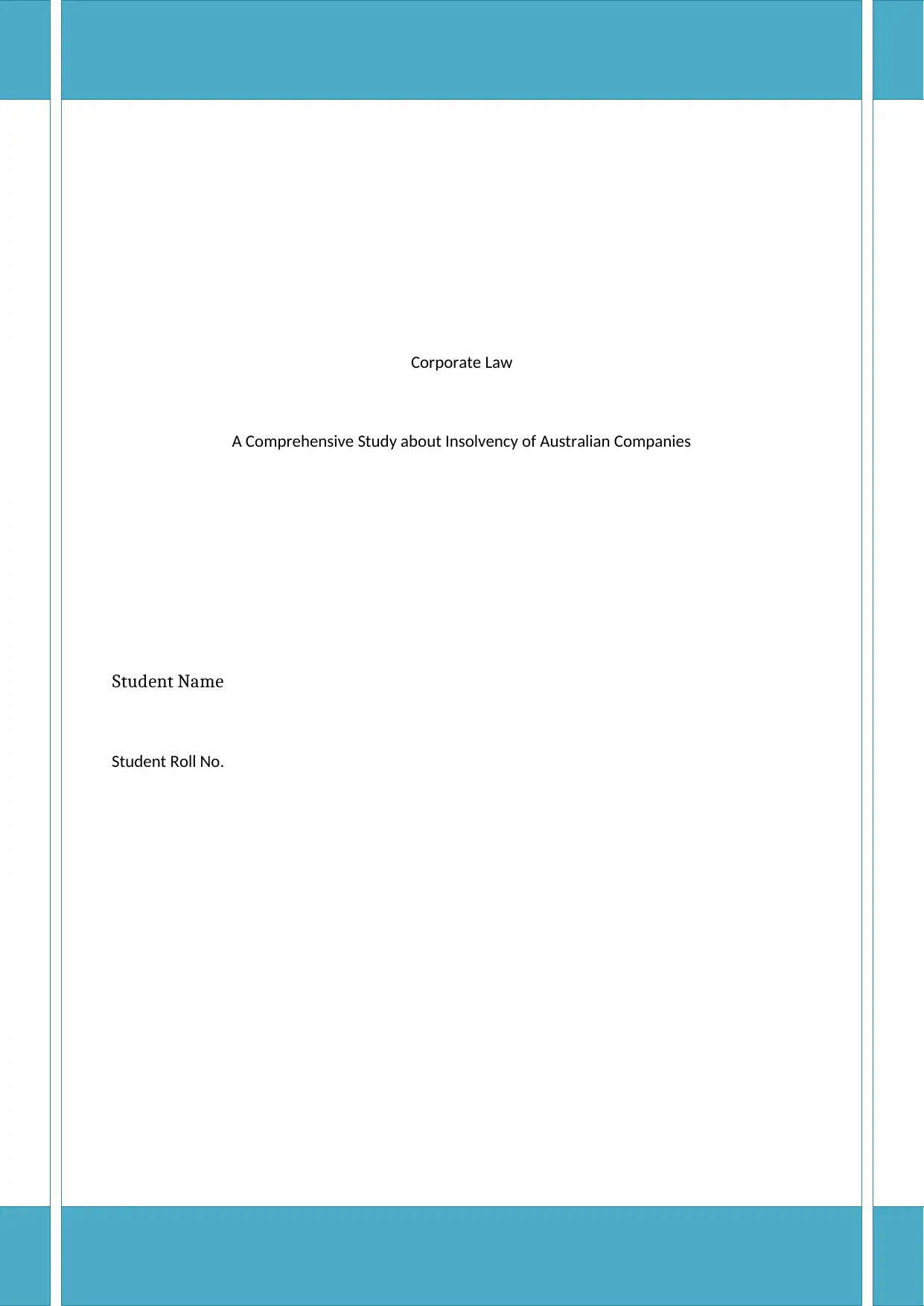
Corporate Law
A Comprehensive Study about Insolvency of Australian Companies
Student Name
Student Roll No.
A Comprehensive Study about Insolvency of Australian Companies
Student Name
Student Roll No.
Secure Best Marks with AI Grader
Need help grading? Try our AI Grader for instant feedback on your assignments.
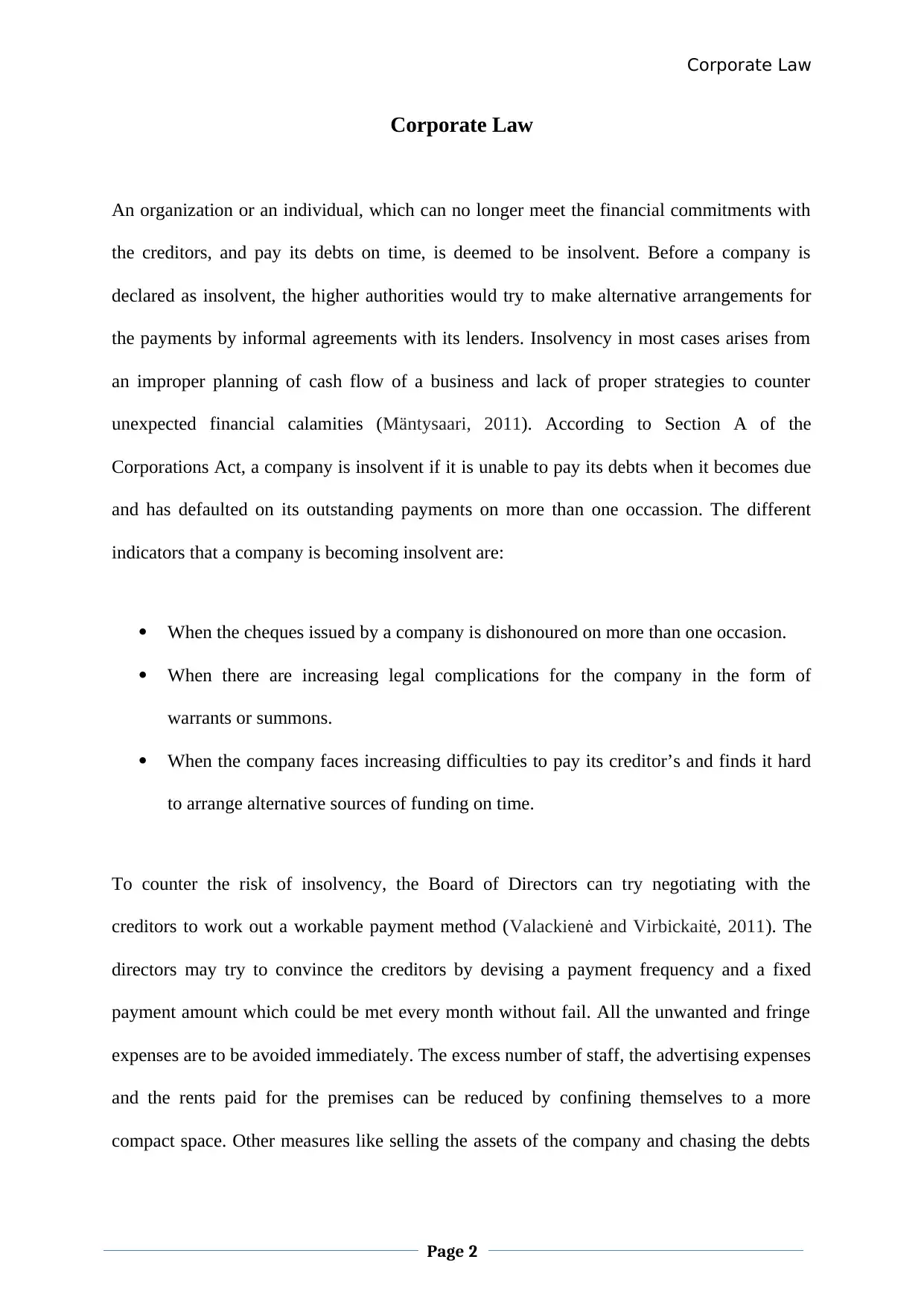
Corporate Law
Corporate Law
An organization or an individual, which can no longer meet the financial commitments with
the creditors, and pay its debts on time, is deemed to be insolvent. Before a company is
declared as insolvent, the higher authorities would try to make alternative arrangements for
the payments by informal agreements with its lenders. Insolvency in most cases arises from
an improper planning of cash flow of a business and lack of proper strategies to counter
unexpected financial calamities (Mäntysaari, 2011). According to Section A of the
Corporations Act, a company is insolvent if it is unable to pay its debts when it becomes due
and has defaulted on its outstanding payments on more than one occassion. The different
indicators that a company is becoming insolvent are:
When the cheques issued by a company is dishonoured on more than one occasion.
When there are increasing legal complications for the company in the form of
warrants or summons.
When the company faces increasing difficulties to pay its creditor’s and finds it hard
to arrange alternative sources of funding on time.
To counter the risk of insolvency, the Board of Directors can try negotiating with the
creditors to work out a workable payment method (Valackienė and Virbickaitė, 2011). The
directors may try to convince the creditors by devising a payment frequency and a fixed
payment amount which could be met every month without fail. All the unwanted and fringe
expenses are to be avoided immediately. The excess number of staff, the advertising expenses
and the rents paid for the premises can be reduced by confining themselves to a more
compact space. Other measures like selling the assets of the company and chasing the debts
Page 2
Corporate Law
An organization or an individual, which can no longer meet the financial commitments with
the creditors, and pay its debts on time, is deemed to be insolvent. Before a company is
declared as insolvent, the higher authorities would try to make alternative arrangements for
the payments by informal agreements with its lenders. Insolvency in most cases arises from
an improper planning of cash flow of a business and lack of proper strategies to counter
unexpected financial calamities (Mäntysaari, 2011). According to Section A of the
Corporations Act, a company is insolvent if it is unable to pay its debts when it becomes due
and has defaulted on its outstanding payments on more than one occassion. The different
indicators that a company is becoming insolvent are:
When the cheques issued by a company is dishonoured on more than one occasion.
When there are increasing legal complications for the company in the form of
warrants or summons.
When the company faces increasing difficulties to pay its creditor’s and finds it hard
to arrange alternative sources of funding on time.
To counter the risk of insolvency, the Board of Directors can try negotiating with the
creditors to work out a workable payment method (Valackienė and Virbickaitė, 2011). The
directors may try to convince the creditors by devising a payment frequency and a fixed
payment amount which could be met every month without fail. All the unwanted and fringe
expenses are to be avoided immediately. The excess number of staff, the advertising expenses
and the rents paid for the premises can be reduced by confining themselves to a more
compact space. Other measures like selling the assets of the company and chasing the debts
Page 2
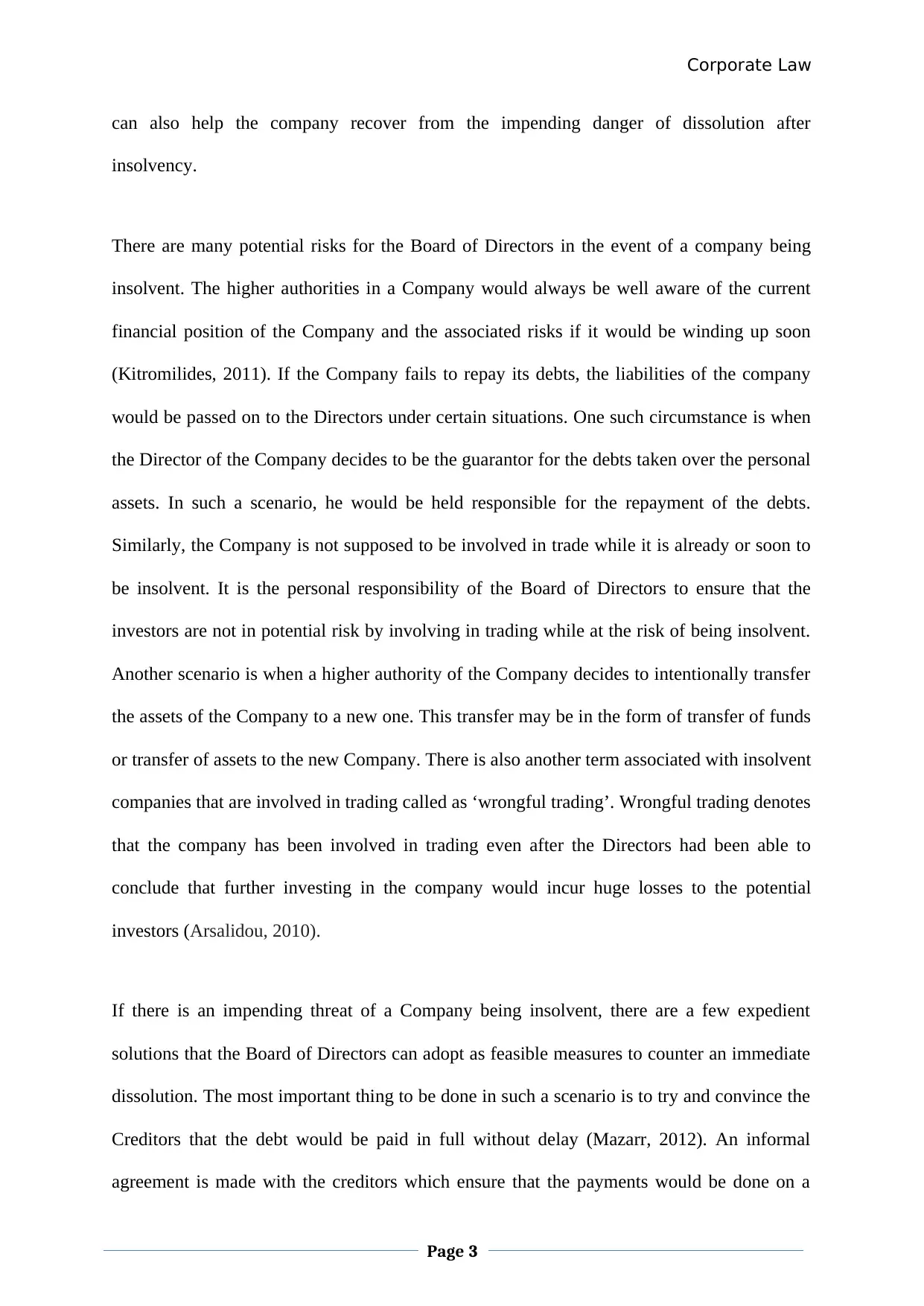
Corporate Law
can also help the company recover from the impending danger of dissolution after
insolvency.
There are many potential risks for the Board of Directors in the event of a company being
insolvent. The higher authorities in a Company would always be well aware of the current
financial position of the Company and the associated risks if it would be winding up soon
(Kitromilides, 2011). If the Company fails to repay its debts, the liabilities of the company
would be passed on to the Directors under certain situations. One such circumstance is when
the Director of the Company decides to be the guarantor for the debts taken over the personal
assets. In such a scenario, he would be held responsible for the repayment of the debts.
Similarly, the Company is not supposed to be involved in trade while it is already or soon to
be insolvent. It is the personal responsibility of the Board of Directors to ensure that the
investors are not in potential risk by involving in trading while at the risk of being insolvent.
Another scenario is when a higher authority of the Company decides to intentionally transfer
the assets of the Company to a new one. This transfer may be in the form of transfer of funds
or transfer of assets to the new Company. There is also another term associated with insolvent
companies that are involved in trading called as ‘wrongful trading’. Wrongful trading denotes
that the company has been involved in trading even after the Directors had been able to
conclude that further investing in the company would incur huge losses to the potential
investors (Arsalidou, 2010).
If there is an impending threat of a Company being insolvent, there are a few expedient
solutions that the Board of Directors can adopt as feasible measures to counter an immediate
dissolution. The most important thing to be done in such a scenario is to try and convince the
Creditors that the debt would be paid in full without delay (Mazarr, 2012). An informal
agreement is made with the creditors which ensure that the payments would be done on a
Page 3
can also help the company recover from the impending danger of dissolution after
insolvency.
There are many potential risks for the Board of Directors in the event of a company being
insolvent. The higher authorities in a Company would always be well aware of the current
financial position of the Company and the associated risks if it would be winding up soon
(Kitromilides, 2011). If the Company fails to repay its debts, the liabilities of the company
would be passed on to the Directors under certain situations. One such circumstance is when
the Director of the Company decides to be the guarantor for the debts taken over the personal
assets. In such a scenario, he would be held responsible for the repayment of the debts.
Similarly, the Company is not supposed to be involved in trade while it is already or soon to
be insolvent. It is the personal responsibility of the Board of Directors to ensure that the
investors are not in potential risk by involving in trading while at the risk of being insolvent.
Another scenario is when a higher authority of the Company decides to intentionally transfer
the assets of the Company to a new one. This transfer may be in the form of transfer of funds
or transfer of assets to the new Company. There is also another term associated with insolvent
companies that are involved in trading called as ‘wrongful trading’. Wrongful trading denotes
that the company has been involved in trading even after the Directors had been able to
conclude that further investing in the company would incur huge losses to the potential
investors (Arsalidou, 2010).
If there is an impending threat of a Company being insolvent, there are a few expedient
solutions that the Board of Directors can adopt as feasible measures to counter an immediate
dissolution. The most important thing to be done in such a scenario is to try and convince the
Creditors that the debt would be paid in full without delay (Mazarr, 2012). An informal
agreement is made with the creditors which ensure that the payments would be done on a
Page 3
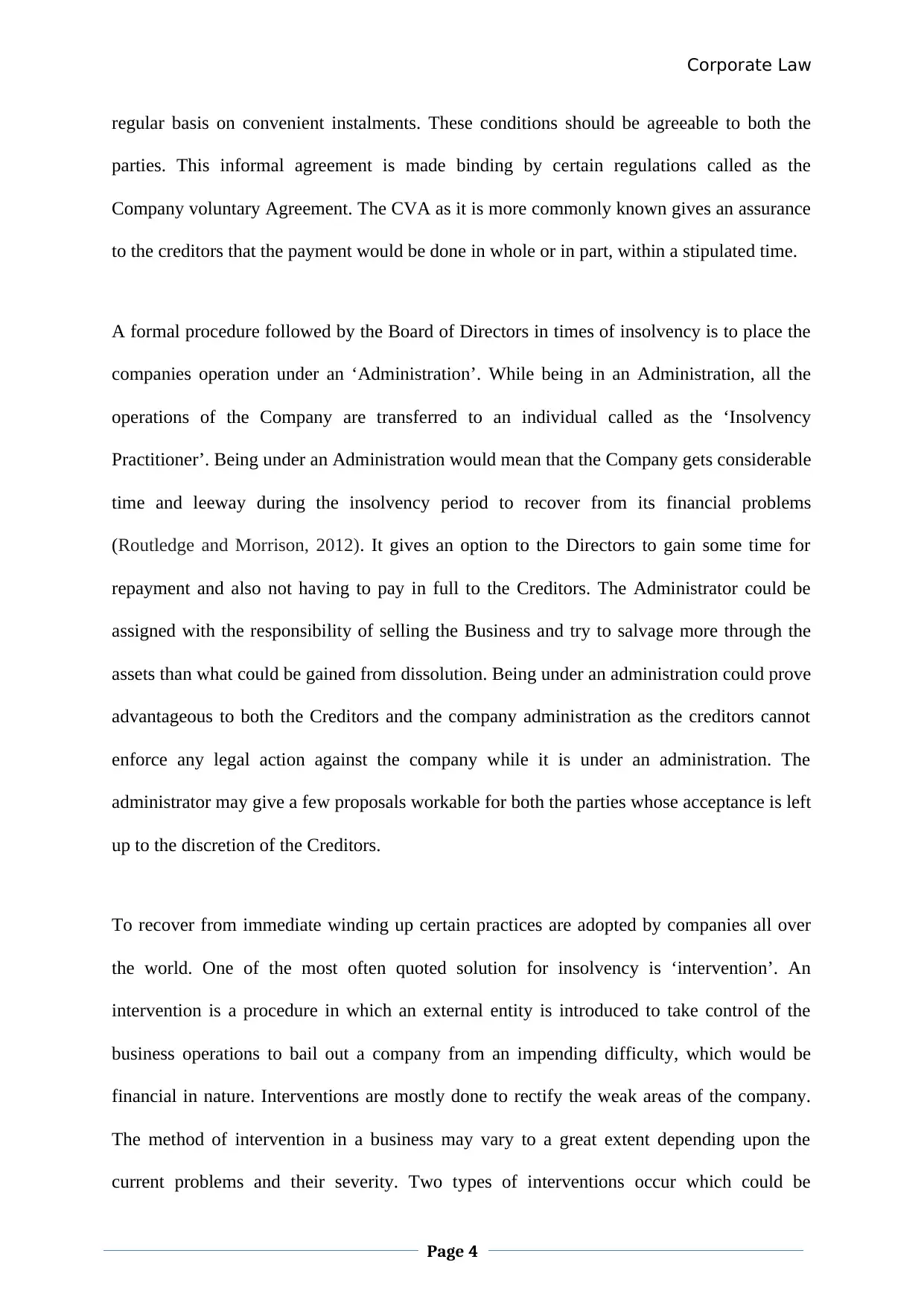
Corporate Law
regular basis on convenient instalments. These conditions should be agreeable to both the
parties. This informal agreement is made binding by certain regulations called as the
Company voluntary Agreement. The CVA as it is more commonly known gives an assurance
to the creditors that the payment would be done in whole or in part, within a stipulated time.
A formal procedure followed by the Board of Directors in times of insolvency is to place the
companies operation under an ‘Administration’. While being in an Administration, all the
operations of the Company are transferred to an individual called as the ‘Insolvency
Practitioner’. Being under an Administration would mean that the Company gets considerable
time and leeway during the insolvency period to recover from its financial problems
(Routledge and Morrison, 2012). It gives an option to the Directors to gain some time for
repayment and also not having to pay in full to the Creditors. The Administrator could be
assigned with the responsibility of selling the Business and try to salvage more through the
assets than what could be gained from dissolution. Being under an administration could prove
advantageous to both the Creditors and the company administration as the creditors cannot
enforce any legal action against the company while it is under an administration. The
administrator may give a few proposals workable for both the parties whose acceptance is left
up to the discretion of the Creditors.
To recover from immediate winding up certain practices are adopted by companies all over
the world. One of the most often quoted solution for insolvency is ‘intervention’. An
intervention is a procedure in which an external entity is introduced to take control of the
business operations to bail out a company from an impending difficulty, which would be
financial in nature. Interventions are mostly done to rectify the weak areas of the company.
The method of intervention in a business may vary to a great extent depending upon the
current problems and their severity. Two types of interventions occur which could be
Page 4
regular basis on convenient instalments. These conditions should be agreeable to both the
parties. This informal agreement is made binding by certain regulations called as the
Company voluntary Agreement. The CVA as it is more commonly known gives an assurance
to the creditors that the payment would be done in whole or in part, within a stipulated time.
A formal procedure followed by the Board of Directors in times of insolvency is to place the
companies operation under an ‘Administration’. While being in an Administration, all the
operations of the Company are transferred to an individual called as the ‘Insolvency
Practitioner’. Being under an Administration would mean that the Company gets considerable
time and leeway during the insolvency period to recover from its financial problems
(Routledge and Morrison, 2012). It gives an option to the Directors to gain some time for
repayment and also not having to pay in full to the Creditors. The Administrator could be
assigned with the responsibility of selling the Business and try to salvage more through the
assets than what could be gained from dissolution. Being under an administration could prove
advantageous to both the Creditors and the company administration as the creditors cannot
enforce any legal action against the company while it is under an administration. The
administrator may give a few proposals workable for both the parties whose acceptance is left
up to the discretion of the Creditors.
To recover from immediate winding up certain practices are adopted by companies all over
the world. One of the most often quoted solution for insolvency is ‘intervention’. An
intervention is a procedure in which an external entity is introduced to take control of the
business operations to bail out a company from an impending difficulty, which would be
financial in nature. Interventions are mostly done to rectify the weak areas of the company.
The method of intervention in a business may vary to a great extent depending upon the
current problems and their severity. Two types of interventions occur which could be
Page 4
Secure Best Marks with AI Grader
Need help grading? Try our AI Grader for instant feedback on your assignments.
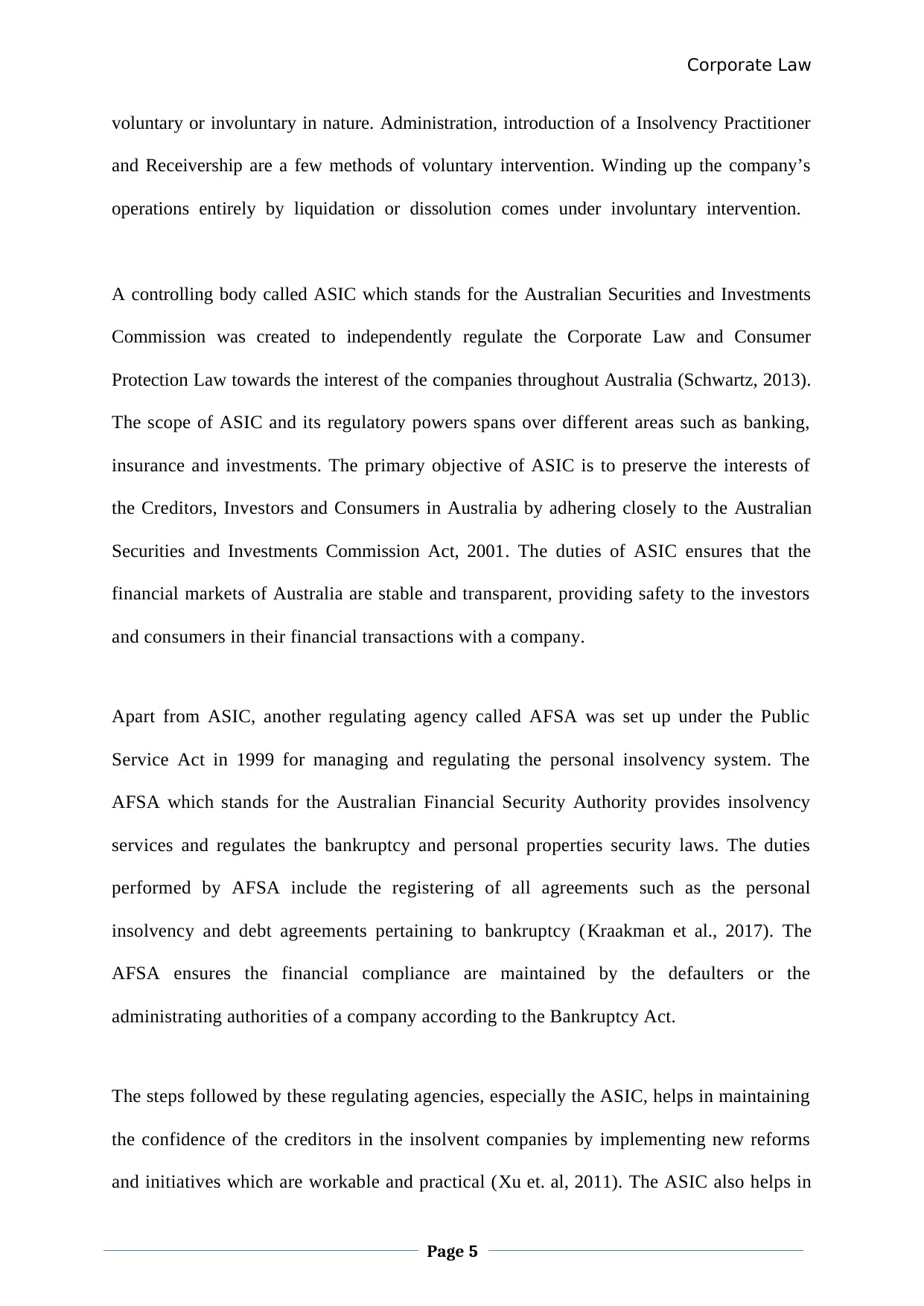
Corporate Law
voluntary or involuntary in nature. Administration, introduction of a Insolvency Practitioner
and Receivership are a few methods of voluntary intervention. Winding up the company’s
operations entirely by liquidation or dissolution comes under involuntary intervention.
A controlling body called ASIC which stands for the Australian Securities and Investments
Commission was created to independently regulate the Corporate Law and Consumer
Protection Law towards the interest of the companies throughout Australia (Schwartz, 2013).
The scope of ASIC and its regulatory powers spans over different areas such as banking,
insurance and investments. The primary objective of ASIC is to preserve the interests of
the Creditors, Investors and Consumers in Australia by adhering closely to the Australian
Securities and Investments Commission Act, 2001. The duties of ASIC ensures that the
financial markets of Australia are stable and transparent, providing safety to the investors
and consumers in their financial transactions with a company.
Apart from ASIC, another regulating agency called AFSA was set up under the Public
Service Act in 1999 for managing and regulating the personal insolvency system. The
AFSA which stands for the Australian Financial Security Authority provides insolvency
services and regulates the bankruptcy and personal properties security laws. The duties
performed by AFSA include the registering of all agreements such as the personal
insolvency and debt agreements pertaining to bankruptcy (Kraakman et al., 2017). The
AFSA ensures the financial compliance are maintained by the defaulters or the
administrating authorities of a company according to the Bankruptcy Act.
The steps followed by these regulating agencies, especially the ASIC, helps in maintaining
the confidence of the creditors in the insolvent companies by implementing new reforms
and initiatives which are workable and practical (Xu et. al, 2011). The ASIC also helps in
Page 5
voluntary or involuntary in nature. Administration, introduction of a Insolvency Practitioner
and Receivership are a few methods of voluntary intervention. Winding up the company’s
operations entirely by liquidation or dissolution comes under involuntary intervention.
A controlling body called ASIC which stands for the Australian Securities and Investments
Commission was created to independently regulate the Corporate Law and Consumer
Protection Law towards the interest of the companies throughout Australia (Schwartz, 2013).
The scope of ASIC and its regulatory powers spans over different areas such as banking,
insurance and investments. The primary objective of ASIC is to preserve the interests of
the Creditors, Investors and Consumers in Australia by adhering closely to the Australian
Securities and Investments Commission Act, 2001. The duties of ASIC ensures that the
financial markets of Australia are stable and transparent, providing safety to the investors
and consumers in their financial transactions with a company.
Apart from ASIC, another regulating agency called AFSA was set up under the Public
Service Act in 1999 for managing and regulating the personal insolvency system. The
AFSA which stands for the Australian Financial Security Authority provides insolvency
services and regulates the bankruptcy and personal properties security laws. The duties
performed by AFSA include the registering of all agreements such as the personal
insolvency and debt agreements pertaining to bankruptcy (Kraakman et al., 2017). The
AFSA ensures the financial compliance are maintained by the defaulters or the
administrating authorities of a company according to the Bankruptcy Act.
The steps followed by these regulating agencies, especially the ASIC, helps in maintaining
the confidence of the creditors in the insolvent companies by implementing new reforms
and initiatives which are workable and practical (Xu et. al, 2011). The ASIC also helps in
Page 5
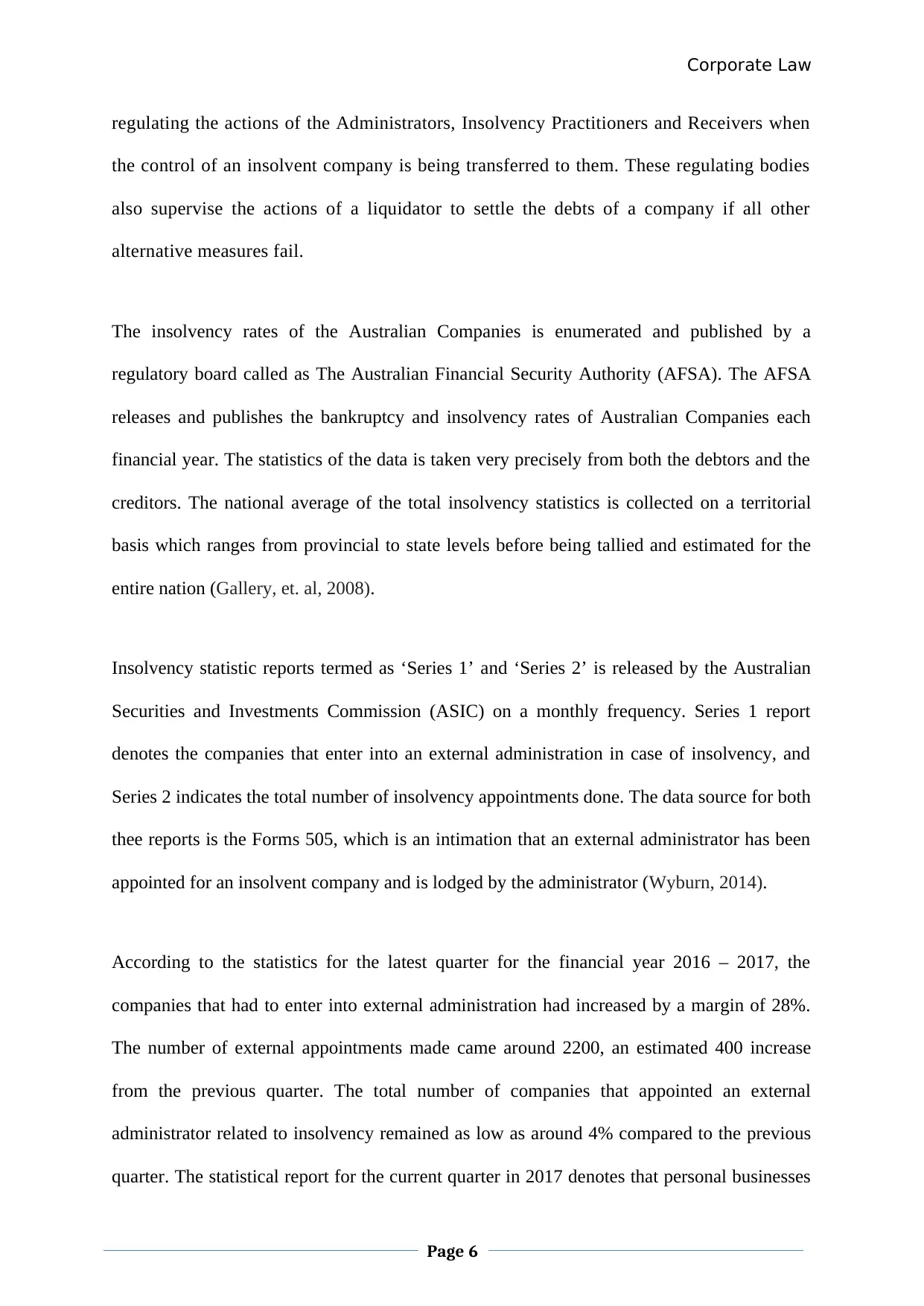
Corporate Law
regulating the actions of the Administrators, Insolvency Practitioners and Receivers when
the control of an insolvent company is being transferred to them. These regulating bodies
also supervise the actions of a liquidator to settle the debts of a company if all other
alternative measures fail.
The insolvency rates of the Australian Companies is enumerated and published by a
regulatory board called as The Australian Financial Security Authority (AFSA). The AFSA
releases and publishes the bankruptcy and insolvency rates of Australian Companies each
financial year. The statistics of the data is taken very precisely from both the debtors and the
creditors. The national average of the total insolvency statistics is collected on a territorial
basis which ranges from provincial to state levels before being tallied and estimated for the
entire nation (Gallery, et. al, 2008).
Insolvency statistic reports termed as ‘Series 1’ and ‘Series 2’ is released by the Australian
Securities and Investments Commission (ASIC) on a monthly frequency. Series 1 report
denotes the companies that enter into an external administration in case of insolvency, and
Series 2 indicates the total number of insolvency appointments done. The data source for both
thee reports is the Forms 505, which is an intimation that an external administrator has been
appointed for an insolvent company and is lodged by the administrator (Wyburn, 2014).
According to the statistics for the latest quarter for the financial year 2016 – 2017, the
companies that had to enter into external administration had increased by a margin of 28%.
The number of external appointments made came around 2200, an estimated 400 increase
from the previous quarter. The total number of companies that appointed an external
administrator related to insolvency remained as low as around 4% compared to the previous
quarter. The statistical report for the current quarter in 2017 denotes that personal businesses
Page 6
regulating the actions of the Administrators, Insolvency Practitioners and Receivers when
the control of an insolvent company is being transferred to them. These regulating bodies
also supervise the actions of a liquidator to settle the debts of a company if all other
alternative measures fail.
The insolvency rates of the Australian Companies is enumerated and published by a
regulatory board called as The Australian Financial Security Authority (AFSA). The AFSA
releases and publishes the bankruptcy and insolvency rates of Australian Companies each
financial year. The statistics of the data is taken very precisely from both the debtors and the
creditors. The national average of the total insolvency statistics is collected on a territorial
basis which ranges from provincial to state levels before being tallied and estimated for the
entire nation (Gallery, et. al, 2008).
Insolvency statistic reports termed as ‘Series 1’ and ‘Series 2’ is released by the Australian
Securities and Investments Commission (ASIC) on a monthly frequency. Series 1 report
denotes the companies that enter into an external administration in case of insolvency, and
Series 2 indicates the total number of insolvency appointments done. The data source for both
thee reports is the Forms 505, which is an intimation that an external administrator has been
appointed for an insolvent company and is lodged by the administrator (Wyburn, 2014).
According to the statistics for the latest quarter for the financial year 2016 – 2017, the
companies that had to enter into external administration had increased by a margin of 28%.
The number of external appointments made came around 2200, an estimated 400 increase
from the previous quarter. The total number of companies that appointed an external
administrator related to insolvency remained as low as around 4% compared to the previous
quarter. The statistical report for the current quarter in 2017 denotes that personal businesses
Page 6
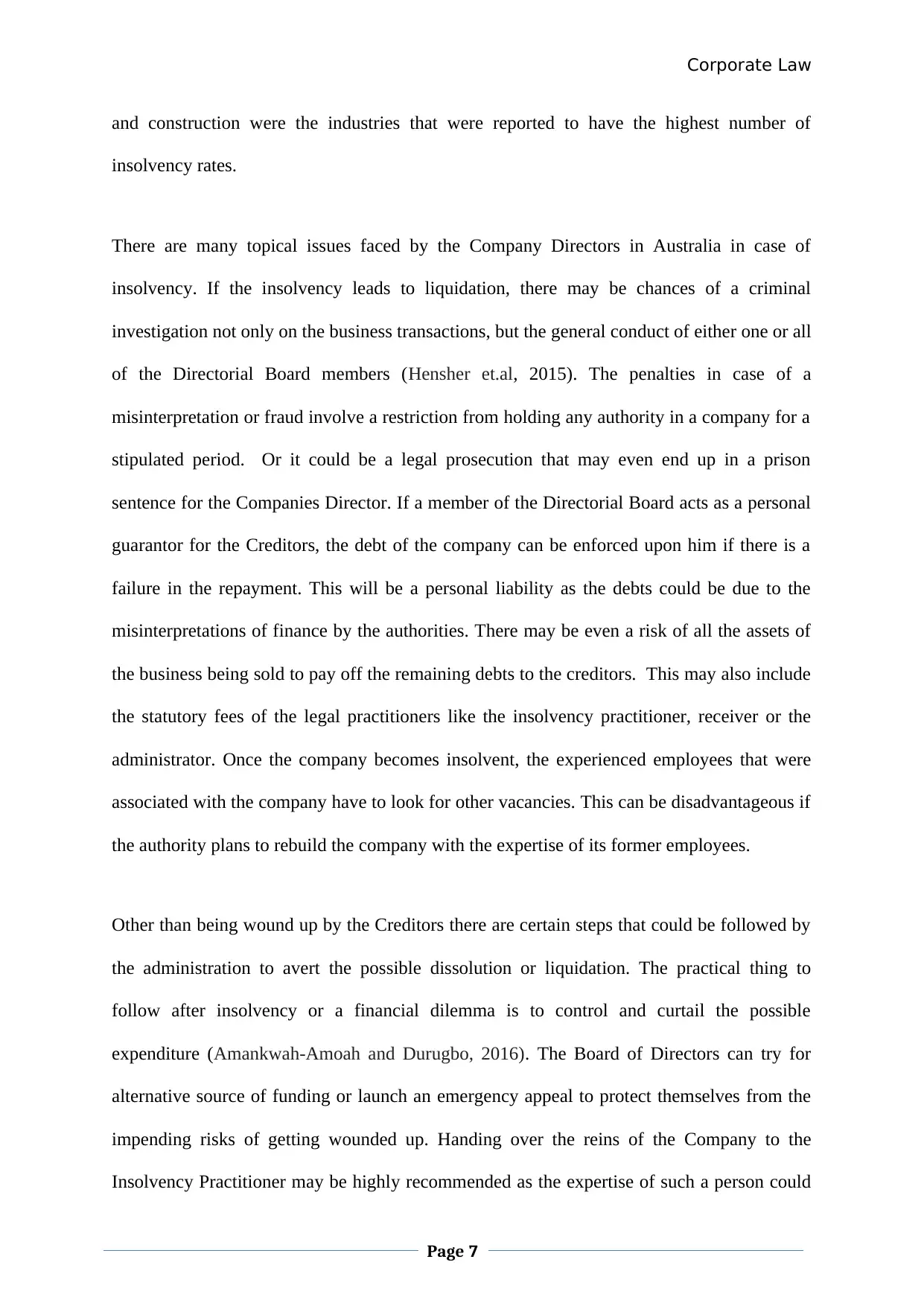
Corporate Law
and construction were the industries that were reported to have the highest number of
insolvency rates.
There are many topical issues faced by the Company Directors in Australia in case of
insolvency. If the insolvency leads to liquidation, there may be chances of a criminal
investigation not only on the business transactions, but the general conduct of either one or all
of the Directorial Board members (Hensher et.al, 2015). The penalties in case of a
misinterpretation or fraud involve a restriction from holding any authority in a company for a
stipulated period. Or it could be a legal prosecution that may even end up in a prison
sentence for the Companies Director. If a member of the Directorial Board acts as a personal
guarantor for the Creditors, the debt of the company can be enforced upon him if there is a
failure in the repayment. This will be a personal liability as the debts could be due to the
misinterpretations of finance by the authorities. There may be even a risk of all the assets of
the business being sold to pay off the remaining debts to the creditors. This may also include
the statutory fees of the legal practitioners like the insolvency practitioner, receiver or the
administrator. Once the company becomes insolvent, the experienced employees that were
associated with the company have to look for other vacancies. This can be disadvantageous if
the authority plans to rebuild the company with the expertise of its former employees.
Other than being wound up by the Creditors there are certain steps that could be followed by
the administration to avert the possible dissolution or liquidation. The practical thing to
follow after insolvency or a financial dilemma is to control and curtail the possible
expenditure (Amankwah-Amoah and Durugbo, 2016). The Board of Directors can try for
alternative source of funding or launch an emergency appeal to protect themselves from the
impending risks of getting wounded up. Handing over the reins of the Company to the
Insolvency Practitioner may be highly recommended as the expertise of such a person could
Page 7
and construction were the industries that were reported to have the highest number of
insolvency rates.
There are many topical issues faced by the Company Directors in Australia in case of
insolvency. If the insolvency leads to liquidation, there may be chances of a criminal
investigation not only on the business transactions, but the general conduct of either one or all
of the Directorial Board members (Hensher et.al, 2015). The penalties in case of a
misinterpretation or fraud involve a restriction from holding any authority in a company for a
stipulated period. Or it could be a legal prosecution that may even end up in a prison
sentence for the Companies Director. If a member of the Directorial Board acts as a personal
guarantor for the Creditors, the debt of the company can be enforced upon him if there is a
failure in the repayment. This will be a personal liability as the debts could be due to the
misinterpretations of finance by the authorities. There may be even a risk of all the assets of
the business being sold to pay off the remaining debts to the creditors. This may also include
the statutory fees of the legal practitioners like the insolvency practitioner, receiver or the
administrator. Once the company becomes insolvent, the experienced employees that were
associated with the company have to look for other vacancies. This can be disadvantageous if
the authority plans to rebuild the company with the expertise of its former employees.
Other than being wound up by the Creditors there are certain steps that could be followed by
the administration to avert the possible dissolution or liquidation. The practical thing to
follow after insolvency or a financial dilemma is to control and curtail the possible
expenditure (Amankwah-Amoah and Durugbo, 2016). The Board of Directors can try for
alternative source of funding or launch an emergency appeal to protect themselves from the
impending risks of getting wounded up. Handing over the reins of the Company to the
Insolvency Practitioner may be highly recommended as the expertise of such a person could
Page 7
Paraphrase This Document
Need a fresh take? Get an instant paraphrase of this document with our AI Paraphraser
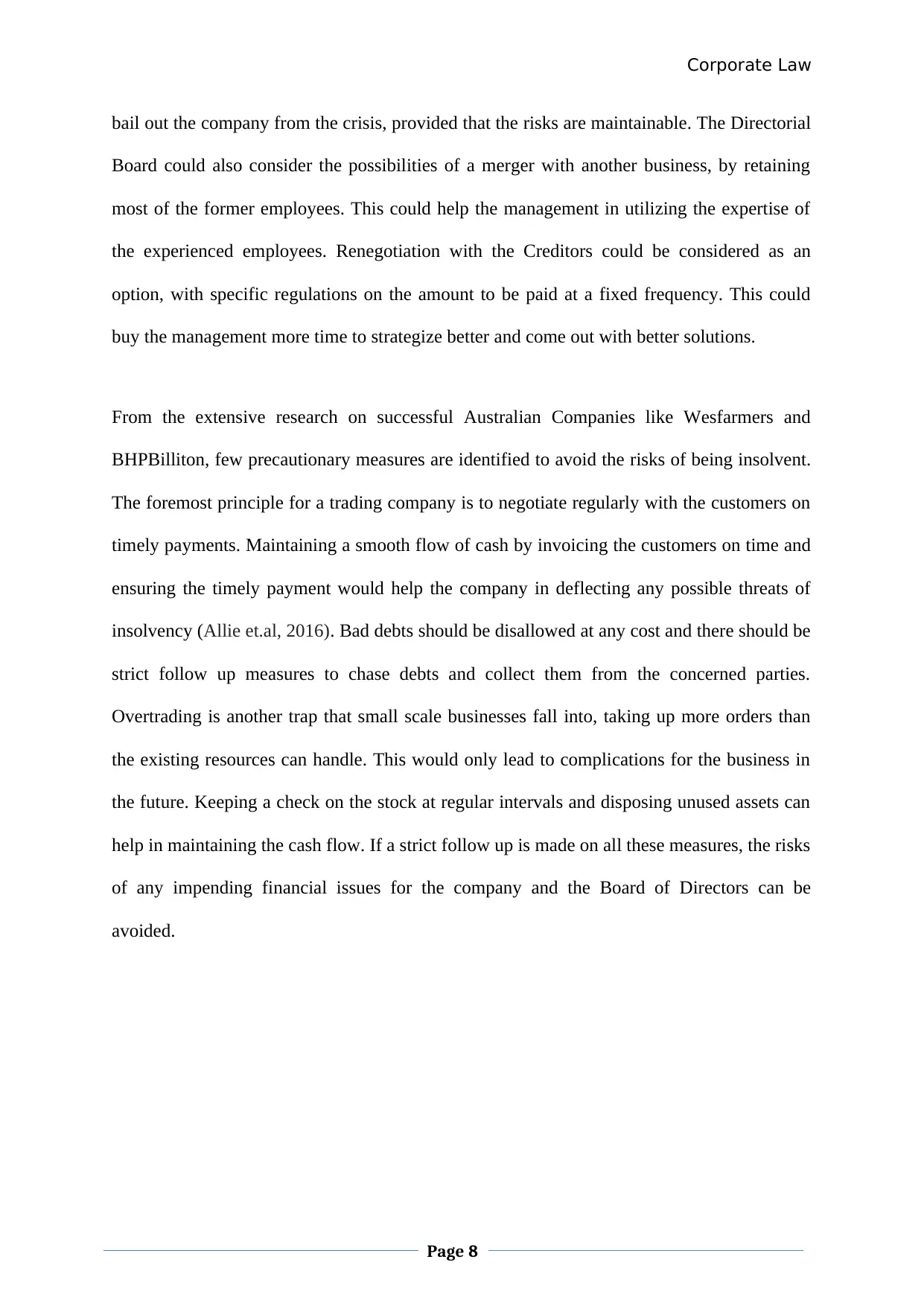
Corporate Law
bail out the company from the crisis, provided that the risks are maintainable. The Directorial
Board could also consider the possibilities of a merger with another business, by retaining
most of the former employees. This could help the management in utilizing the expertise of
the experienced employees. Renegotiation with the Creditors could be considered as an
option, with specific regulations on the amount to be paid at a fixed frequency. This could
buy the management more time to strategize better and come out with better solutions.
From the extensive research on successful Australian Companies like Wesfarmers and
BHPBilliton, few precautionary measures are identified to avoid the risks of being insolvent.
The foremost principle for a trading company is to negotiate regularly with the customers on
timely payments. Maintaining a smooth flow of cash by invoicing the customers on time and
ensuring the timely payment would help the company in deflecting any possible threats of
insolvency (Allie et.al, 2016). Bad debts should be disallowed at any cost and there should be
strict follow up measures to chase debts and collect them from the concerned parties.
Overtrading is another trap that small scale businesses fall into, taking up more orders than
the existing resources can handle. This would only lead to complications for the business in
the future. Keeping a check on the stock at regular intervals and disposing unused assets can
help in maintaining the cash flow. If a strict follow up is made on all these measures, the risks
of any impending financial issues for the company and the Board of Directors can be
avoided.
Page 8
bail out the company from the crisis, provided that the risks are maintainable. The Directorial
Board could also consider the possibilities of a merger with another business, by retaining
most of the former employees. This could help the management in utilizing the expertise of
the experienced employees. Renegotiation with the Creditors could be considered as an
option, with specific regulations on the amount to be paid at a fixed frequency. This could
buy the management more time to strategize better and come out with better solutions.
From the extensive research on successful Australian Companies like Wesfarmers and
BHPBilliton, few precautionary measures are identified to avoid the risks of being insolvent.
The foremost principle for a trading company is to negotiate regularly with the customers on
timely payments. Maintaining a smooth flow of cash by invoicing the customers on time and
ensuring the timely payment would help the company in deflecting any possible threats of
insolvency (Allie et.al, 2016). Bad debts should be disallowed at any cost and there should be
strict follow up measures to chase debts and collect them from the concerned parties.
Overtrading is another trap that small scale businesses fall into, taking up more orders than
the existing resources can handle. This would only lead to complications for the business in
the future. Keeping a check on the stock at regular intervals and disposing unused assets can
help in maintaining the cash flow. If a strict follow up is made on all these measures, the risks
of any impending financial issues for the company and the Board of Directors can be
avoided.
Page 8
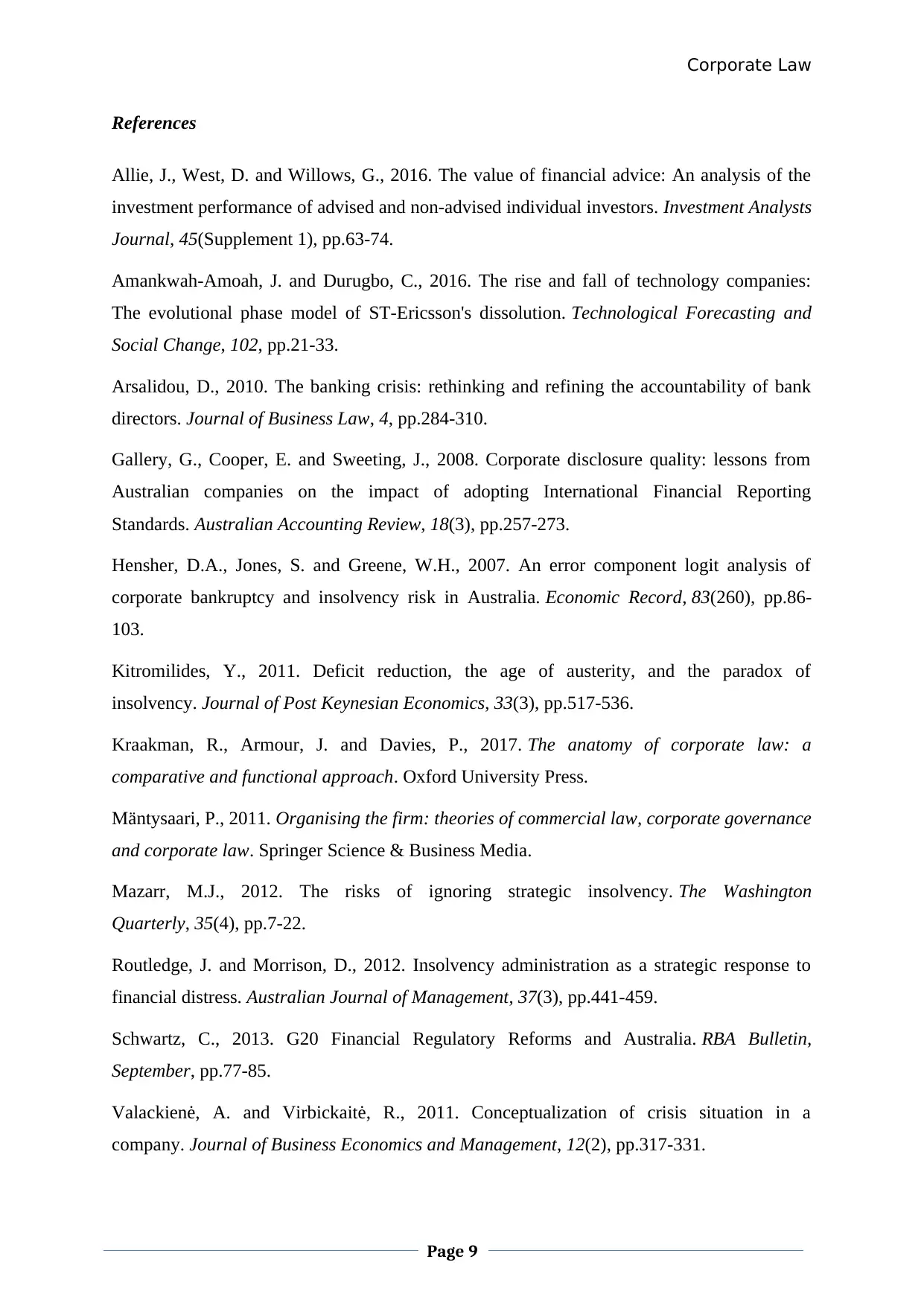
Corporate Law
References
Allie, J., West, D. and Willows, G., 2016. The value of financial advice: An analysis of the
investment performance of advised and non-advised individual investors. Investment Analysts
Journal, 45(Supplement 1), pp.63-74.
Amankwah-Amoah, J. and Durugbo, C., 2016. The rise and fall of technology companies:
The evolutional phase model of ST-Ericsson's dissolution. Technological Forecasting and
Social Change, 102, pp.21-33.
Arsalidou, D., 2010. The banking crisis: rethinking and refining the accountability of bank
directors. Journal of Business Law, 4, pp.284-310.
Gallery, G., Cooper, E. and Sweeting, J., 2008. Corporate disclosure quality: lessons from
Australian companies on the impact of adopting International Financial Reporting
Standards. Australian Accounting Review, 18(3), pp.257-273.
Hensher, D.A., Jones, S. and Greene, W.H., 2007. An error component logit analysis of
corporate bankruptcy and insolvency risk in Australia. Economic Record, 83(260), pp.86-
103.
Kitromilides, Y., 2011. Deficit reduction, the age of austerity, and the paradox of
insolvency. Journal of Post Keynesian Economics, 33(3), pp.517-536.
Kraakman, R., Armour, J. and Davies, P., 2017. The anatomy of corporate law: a
comparative and functional approach. Oxford University Press.
Mäntysaari, P., 2011. Organising the firm: theories of commercial law, corporate governance
and corporate law. Springer Science & Business Media.
Mazarr, M.J., 2012. The risks of ignoring strategic insolvency. The Washington
Quarterly, 35(4), pp.7-22.
Routledge, J. and Morrison, D., 2012. Insolvency administration as a strategic response to
financial distress. Australian Journal of Management, 37(3), pp.441-459.
Schwartz, C., 2013. G20 Financial Regulatory Reforms and Australia. RBA Bulletin,
September, pp.77-85.
Valackienė, A. and Virbickaitė, R., 2011. Conceptualization of crisis situation in a
company. Journal of Business Economics and Management, 12(2), pp.317-331.
Page 9
References
Allie, J., West, D. and Willows, G., 2016. The value of financial advice: An analysis of the
investment performance of advised and non-advised individual investors. Investment Analysts
Journal, 45(Supplement 1), pp.63-74.
Amankwah-Amoah, J. and Durugbo, C., 2016. The rise and fall of technology companies:
The evolutional phase model of ST-Ericsson's dissolution. Technological Forecasting and
Social Change, 102, pp.21-33.
Arsalidou, D., 2010. The banking crisis: rethinking and refining the accountability of bank
directors. Journal of Business Law, 4, pp.284-310.
Gallery, G., Cooper, E. and Sweeting, J., 2008. Corporate disclosure quality: lessons from
Australian companies on the impact of adopting International Financial Reporting
Standards. Australian Accounting Review, 18(3), pp.257-273.
Hensher, D.A., Jones, S. and Greene, W.H., 2007. An error component logit analysis of
corporate bankruptcy and insolvency risk in Australia. Economic Record, 83(260), pp.86-
103.
Kitromilides, Y., 2011. Deficit reduction, the age of austerity, and the paradox of
insolvency. Journal of Post Keynesian Economics, 33(3), pp.517-536.
Kraakman, R., Armour, J. and Davies, P., 2017. The anatomy of corporate law: a
comparative and functional approach. Oxford University Press.
Mäntysaari, P., 2011. Organising the firm: theories of commercial law, corporate governance
and corporate law. Springer Science & Business Media.
Mazarr, M.J., 2012. The risks of ignoring strategic insolvency. The Washington
Quarterly, 35(4), pp.7-22.
Routledge, J. and Morrison, D., 2012. Insolvency administration as a strategic response to
financial distress. Australian Journal of Management, 37(3), pp.441-459.
Schwartz, C., 2013. G20 Financial Regulatory Reforms and Australia. RBA Bulletin,
September, pp.77-85.
Valackienė, A. and Virbickaitė, R., 2011. Conceptualization of crisis situation in a
company. Journal of Business Economics and Management, 12(2), pp.317-331.
Page 9
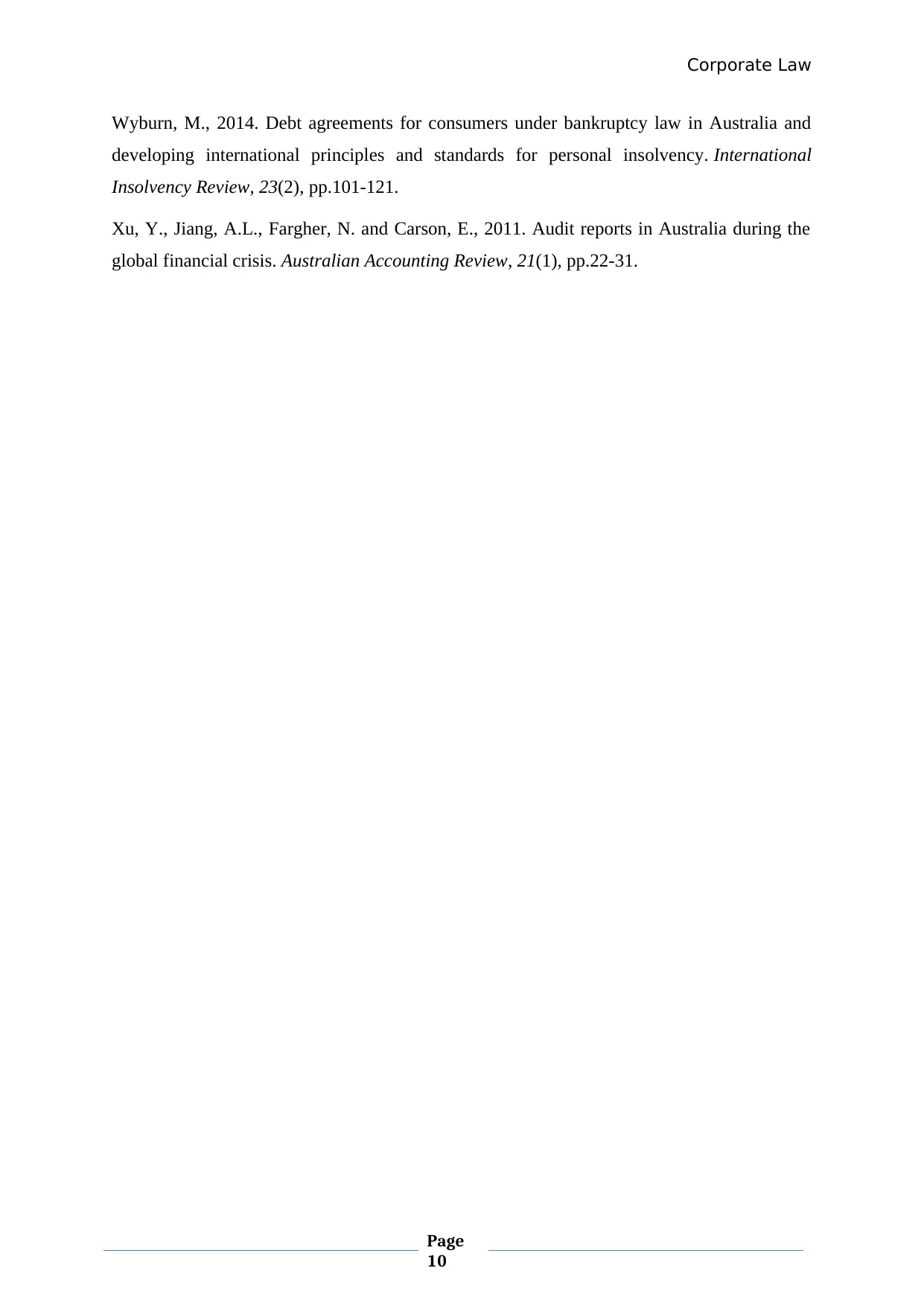
Corporate Law
Wyburn, M., 2014. Debt agreements for consumers under bankruptcy law in Australia and
developing international principles and standards for personal insolvency. International
Insolvency Review, 23(2), pp.101-121.
Xu, Y., Jiang, A.L., Fargher, N. and Carson, E., 2011. Audit reports in Australia during the
global financial crisis. Australian Accounting Review, 21(1), pp.22-31.
Page
10
Wyburn, M., 2014. Debt agreements for consumers under bankruptcy law in Australia and
developing international principles and standards for personal insolvency. International
Insolvency Review, 23(2), pp.101-121.
Xu, Y., Jiang, A.L., Fargher, N. and Carson, E., 2011. Audit reports in Australia during the
global financial crisis. Australian Accounting Review, 21(1), pp.22-31.
Page
10
1 out of 10
Your All-in-One AI-Powered Toolkit for Academic Success.
+13062052269
info@desklib.com
Available 24*7 on WhatsApp / Email
![[object Object]](/_next/static/media/star-bottom.7253800d.svg)
Unlock your academic potential
© 2024 | Zucol Services PVT LTD | All rights reserved.





